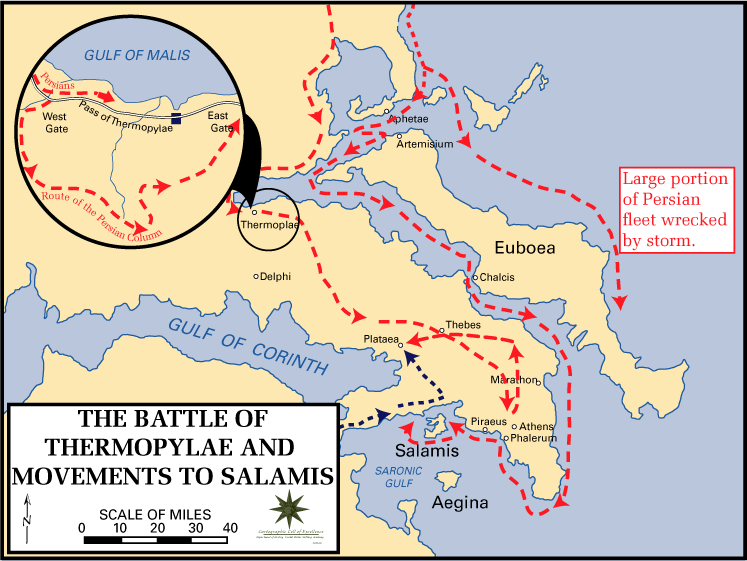Those who haven'e seen "300", then read this & definitely watch the movie.
The Last Stand Of The Brave 300 at The Battle Of Thermopylae.
In the Battle of Thermopylae of 480 BC, an alliance of Greek city-states fought the invading Persian Empire at the pass of Thermopylae in central Greece. Vastly outnumbered, the Greeks held back the Persians for three days in one of history's most famous last stands. A small force led by King Leonidas of Sparta blocked the only road through which the massive army of Xerxes I of Persia (Xerxes the Great) could pass. After three days of battle, a local resident named Ephialtes betrayed the Greeks by revealing a mountain path that led behind the Greek lines. Dismissing the rest of the army, King Leonidas stayed behind with 300 Spartans. The Persians succeeded in taking the pass but sustained heavy losses, extremely disproportionate to those of the Greeks. The fierce resistance of the Spartan-led army offered Athens the invaluable time to prepare for a decisive naval battle that would come to determine the outcome of the war. The subsequent Greek victory at the Battle of Salamis left much of the Persian Empire 's navy destroyed and Xerxes was forced to retreat back to Asia , leaving his army in Greece under Mardonius, who was to meet the Greeks in battle one last time. The Spartans assembled at full strength and led a pan-Greek army that defeated the Persians decisively at the Battle of Plataea, ending the Greco-Persian War and with it the expansion of the Persian Empire into Europe.
The performance of the defenders at the battle of Thermopylae is often used as an example of the advantages of training, equipment, and good use of terrain to maximize an army's potential, and has become a symbol of courage against overwhelming odds. Even more, both ancient and modern writers used the Battle of Thermopylae as an example of the superior power of a well trained army defending native soil.
There is also a large political significance of the Battle of Thermopylae, in that it was the first defining moment in which the disunified Greek city states came together to form a significant alliance. It also possibly signified the beginning of the end for the Persian empire - drawing strength from the Battle, the Greeks began forming assaults against the Persian Empire, as a national body rather than small city states.
Size of the Persian army
Primary sources
Xerxes I, King of Persia , had been preparing for years to continue the Greco-Persian Wars started by his father Darius I. In 481 BC , after four years of preparation, the Persian army and navy arrived in Asia Minor. A bridge of ships had been made at Abydos. This allowed the land forces to cross the Hellespont . Herodotus of Halicarnassus, who wrote the first history of this war, gave the size of Xerxes' army as follows:
| Units | Numbers |
|---|---|
| Fleet crew | 517,610 |
| Infantry | 1,700,000 |
| Cavalry | 80,000 |
| Arabs and Libyans | 20,000 |
| Greek troops allied with Persians | 324,000 |
| Total | 2,641,610 |
This is the account for the land armies present at Thermopylae. Regarding the total number of forces Xerxes I of Persia assembled to invade Greece (land army, fleet crew, etc.), this number is doubled in order to account for support troops and thus Herodotus reports that the total Persian force numbered 5,283,220 men, a figure which is regarded as erroneous by modern estimations. The poet Simonides, who was a contemporary, talks of four million. One century later, Ctesias of Cnidus gives 800,000 as the total number of the original army that met in Doriskos, Thrace , after crossing the Hellespont. Ctesias was Artaxerxes II of Persia's personal physician and wrote a history of Persia, which he claimed was based on Persian royal annals; however, the reliability of his work has been widely disputed both in Antiquity and by modern scholars.
Size of the Greek army
According to Herodotus, the Greek army included the following forces:
| Units | Numbers |
|---|---|
| Spartans | 300 |
| Mantineans | 500 |
| Tegeans | 500 |
| Arcadian Orchomenos | 120 |
| Other Arcadians | 1,000 |
| Corinthians | 400 |
| Phlians | 200 |
| Mycenaeans | 80 |
| Thespians | 700 |
| Thebans | 400 |
| Phocians | 1,000 |
| Opuntian Locrians | 13 |
| Total | 5,513 |
To this number must be added 1,000 other Lacedemonians (Spartan Hoplites) mentioned by Diodorus Siculus and perhaps 800 auxiliary troops from other Greek cities, bringing the total up to 7,000. A further 900 Helots (Spartan serfs) also fought at the battle. Diodorus gives 4,000 as the total of Greek troops, while Pausanias gives 11,200. Many modern historians, who usually consider Herodotus more reliable, prefer his claim of 7,000 men. The numbers changed later on in the battle as, under orders, the entire army retreated and only 2,000 Spartans, Helots, Thespians and Thebans remained.
______________________________________________________________________________
